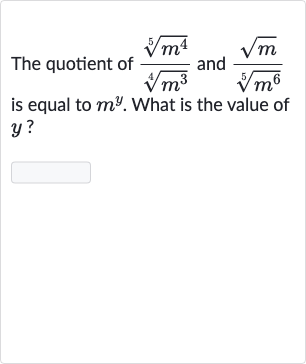Full solution
Q. The quotient of and is equal to . What is the value of ?
- Express Radicals as Exponents: First, let's express the radicals as exponents and write the given expression. can be written as . can be written as . can be written as . can be written as .So the expression becomes:
- Simplify Using Quotient Rule: Next, we simplify the expression by using the quotient rule of exponents, which states that .For the numerator: For the denominator: Now we need to find a common denominator to subtract the fractions in the exponents.
- Find Common Denominator: For the numerator, the common denominator for and is . So we convert the exponents: For the denominator, the common denominator for and is . So we convert the exponents: Now we have:
- Further Simplify Expression: We can simplify the expression further by using the property that again.So we have:Now we need to find a common denominator to add the fractions in the exponents.
- Add Exponents: The common denominator for and is . So we convert the exponents:Now we simplify the fraction:So the expression simplifies to .
- Equate Exponents: Since the original expression is equal to , we can now equate the exponents:This gives us the value of .
More problems from Relationship between squares and square roots
QuestionGet tutor help

